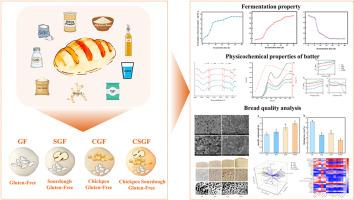Chickpea sourdough as a functional ingredient in gluten-free bread: Impact on quality attributes
IF 11
1区 农林科学
Q1 CHEMISTRY, APPLIED
引用次数: 0
Abstract
Producing gluten-free breads (GF) that meet both sensory and nutritional expectations remains a significant challenge. This study investigated the effects of chickpea flour–based sourdough fermented with Lactobacillus plantarum LB-1 on the pasting properties, rheological behavior of gluten-free batter, and the baking quality of gluten-free bread. The results demonstrated that L. plantarum LB-1 exhibited favorable growth kinetics during 24 h of chickpea sourdough fermentation. Incorporation of chickpea sourdough significantly reduced peak viscosity and breakdown values, while resulting in the highest storage modulus (G′ = 11,347 Pa) and a balanced loss tangent (tan δ = 0.38–0.58). Starch molecular order was progressively enhanced, and protein molecular conformations became more stable. In terms of bread quality evaluation, the chickpea sourdough gluten-free bread (CSGF) showed the greatest specific volume (2.50 mL/g), the lowest baking loss (5.03 %), the lowest crumb hardness (3.93 N), a uniform and dense crumb structure (AF = 29.94 %), and the strongest antioxidant activity. Scanning electron microscopy further confirmed the presence of a homogeneous and compact matrix in CSGF. These findings highlight chickpea sourdough as a promising approach for producing gluten-free bread with improved nutritional value and desirable sensory qualities.

鹰嘴豆酵母作为无麸质面包的功能性成分:对质量属性的影响
生产同时满足感官和营养期望的无谷蛋白面包(GF)仍然是一个重大挑战。本文研究了植物乳杆菌LB-1发酵鹰嘴豆粉酵母对无麸质面糊糊化性能、流变学行为以及无麸质面包烘焙品质的影响。结果表明,L. plantarum LB-1在鹰嘴豆酵母发酵24 h内表现出良好的生长动力学。鹰嘴豆酵母的加入显著降低了峰值粘度和破裂值,同时导致最高的储存模量(G′= 11,347 Pa)和平衡的损失切线(tan δ = 0.38-0.58)。淀粉分子秩序逐渐增强,蛋白质分子构象更加稳定。在面包品质评价方面,鹰嘴豆酵母无麸质面包(CSGF)的比体积最大(2.50 mL/g),烘焙损失最低(5.03%),面包屑硬度最低(3.93 N),面包屑结构均匀致密(AF = 29.94%),抗氧化活性最强。扫描电镜进一步证实了CSGF中存在均匀致密的基质。这些发现强调了鹰嘴豆酵母作为一种很有前途的方法来生产无麸质面包,它具有更高的营养价值和理想的感官品质。
本文章由计算机程序翻译,如有差异,请以英文原文为准。
求助全文
约1分钟内获得全文
求助全文
来源期刊

Food Hydrocolloids
工程技术-食品科技
CiteScore
19.90
自引率
14.00%
发文量
871
审稿时长
37 days
期刊介绍:
Food Hydrocolloids publishes original and innovative research focused on the characterization, functional properties, and applications of hydrocolloid materials used in food products. These hydrocolloids, defined as polysaccharides and proteins of commercial importance, are added to control aspects such as texture, stability, rheology, and sensory properties. The research's primary emphasis should be on the hydrocolloids themselves, with thorough descriptions of their source, nature, and physicochemical characteristics. Manuscripts are expected to clearly outline specific aims and objectives, include a fundamental discussion of research findings at the molecular level, and address the significance of the results. Studies on hydrocolloids in complex formulations should concentrate on their overall properties and mechanisms of action, while simple formulation development studies may not be considered for publication.
The main areas of interest are:
-Chemical and physicochemical characterisation
Thermal properties including glass transitions and conformational changes-
Rheological properties including viscosity, viscoelastic properties and gelation behaviour-
The influence on organoleptic properties-
Interfacial properties including stabilisation of dispersions, emulsions and foams-
Film forming properties with application to edible films and active packaging-
Encapsulation and controlled release of active compounds-
The influence on health including their role as dietary fibre-
Manipulation of hydrocolloid structure and functionality through chemical, biochemical and physical processes-
New hydrocolloids and hydrocolloid sources of commercial potential.
The Journal also publishes Review articles that provide an overview of the latest developments in topics of specific interest to researchers in this field of activity.
 求助内容:
求助内容: 应助结果提醒方式:
应助结果提醒方式:


